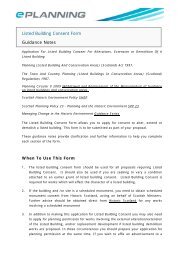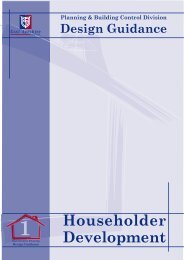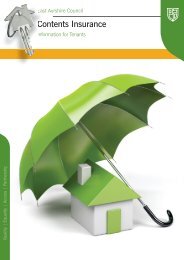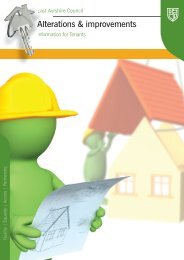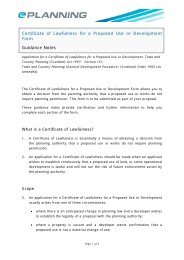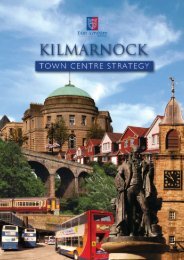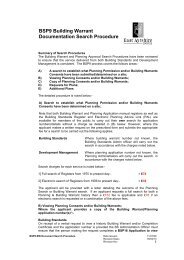MIR Sections 1 & 2 - East Ayrshire Council
MIR Sections 1 & 2 - East Ayrshire Council
MIR Sections 1 & 2 - East Ayrshire Council
Create successful ePaper yourself
Turn your PDF publications into a flip-book with our unique Google optimized e-Paper software.
Quality | Equality | Access | Partnership<strong>East</strong> <strong>Ayrshire</strong> Local Development Plan:Main Issues ReportOctober 2012
Section 1: Introduction and Vision 31.1.1 Welcome to <strong>East</strong> <strong>Ayrshire</strong>’s Main Issues Report (<strong>MIR</strong>). 31.2 Vision 51.5 The Main Issues 8Section 2: Creating sustainable places 9What are the Main Issues? 92.2 Issue 1: Achieving good design 102.3 Issue 2: Recognising and supporting green networks 112.4 Issue 3: Reducing the risk of flooding 14ACTION ON CLIMATE CHANGE 15<strong>East</strong> <strong>Ayrshire</strong> Local Development Plan: Main Issues Report 3: The location and supply of housing 2
1Section 1:Introduction and Vision1.1.1 Welcome to <strong>East</strong> <strong>Ayrshire</strong>’s Main Issues Report (<strong>MIR</strong>).This document is the first stage in the preparation of our LocalDevelopment Plan (LDP). It sets out what we want <strong>East</strong> <strong>Ayrshire</strong> to be like in20 years’ time and presents 34 issues for future development that we wantpeople’s views on. This will help the <strong>Council</strong> to arrive at the strategies,policies and sites in the proposed plan, the next stage of the planpreparation process. The <strong>MIR</strong> does not cover all planning policy matters;instead it concentrates on the key areas of change that have occurredsince our last local plans were adopted. It is expected that much of theprevious local plans’ content remains relevant and therefore do not needto be covered in this <strong>MIR</strong>.<strong>East</strong> <strong>Ayrshire</strong> Local Development Plan: Main Issues Report 1: Introduction3
1.1.2 At the moment the following plans make up the development plan for <strong>East</strong> <strong>Ayrshire</strong>:• <strong>Ayrshire</strong> Joint Structure Plan 2007• <strong>East</strong> <strong>Ayrshire</strong> Local Plan 2010• <strong>East</strong> <strong>Ayrshire</strong> Opencast Coal Subject Plan 20031.1.3 These will all be replaced by the <strong>East</strong> <strong>Ayrshire</strong> Local Development plan when it is adopted in 2015. For full detailson the timetable and various stages of the <strong>East</strong> <strong>Ayrshire</strong> LDP, the <strong>Council</strong>’s development plan scheme can be foundon the <strong>Council</strong>’s website at: www.east-ayrshire.gov.uk1.1.4 Although its preferred options for development are clearly stated, the <strong>Council</strong> is genuinely open to alternativeapproaches and seeks to meaningfully engage with the public and development industry on the big issues affecting<strong>East</strong> <strong>Ayrshire</strong>. A series of questions are posed after each main issue to help with this.1.1.5 In addition to answering the questions set out in the document, representations can also be made on all otheraspects of the <strong>MIR</strong> including any land parcels people wish to be identified for development and if there are any bigissues which are considered to be missing from the document.1.1.6 A formal consultation on this <strong>MIR</strong> begins on Monday 12 November 2012 and ends Friday 25 January 2013.Representations should be as concise as possible and supporting information can be submitted, preferably inelectronic format to: localdevelopmentplans@east-ayrshire.gov.uk1.1.7 Or alternatively in writing to:<strong>East</strong> <strong>Ayrshire</strong> <strong>Council</strong>Planning & Economic Development DivisionDevelopment Planning & Regeneration SectionThe Johnnie Walker Bond15 Strand StreetKilmarnockKA1 1HU1.1.8 Comments can also be submitted via the <strong>Council</strong>’s online local development plan portal. This can be found on the<strong>Council</strong>’s website at: www.east-ayrshire.gov.uk1.1.9 After the consultation period has closed, all representations received will be examined and used alongside the <strong>MIR</strong>to inform the Proposed Plan which is due for publication in 2014. It is envisaged that the <strong>East</strong> <strong>Ayrshire</strong> LocalDevelopment Plan will be adopted by the <strong>Council</strong> in late 2015.Key Documents which have been used to informthe preparation of the Main Issues ReportThe Single Outcome Agreement and the <strong>East</strong> <strong>Ayrshire</strong>Community PlanNational Planning Framework 2The Monitoring StatementDraft <strong>East</strong> <strong>Ayrshire</strong> Housing Needs and Demand Assessment<strong>Ayrshire</strong> Joint Structure Plan 2007Regional Transport Strategy/Local Transport StrategyScottish Planning PolicyPlanning Advice NotesKilmarnock Integrated Urban Development PlanThe Prince’s Foundation for the Built Environment FourTowns ReportsBackground DocumentsTwo background documents to this Main Issues Report areprovided on the <strong>Council</strong>’s website. These are:-1. <strong>East</strong> <strong>Ayrshire</strong> Business and Industrial Land Review.This gives further detailed information on how the<strong>Council</strong> has arrived at its preferred approach2. List of Potential changes to Policies of the <strong>East</strong> <strong>Ayrshire</strong>Local Plan 2010 and the Open Cast Coal Subject Plan2003 and likely Supplementary Guidance to form part ofthe <strong>East</strong> <strong>Ayrshire</strong> Local Development Plan1.1.10 A monitoring statement is published alongside this <strong>MIR</strong> which details what has happened on the ground since theexisting development plan was published and how successful its strategies have been. It forms a large part of theevidence base for the <strong>MIR</strong>.1.1.11 Strategic Environmental AssessmentAll policies and strategies of the <strong>MIR</strong> have been assessed for their likely environmental impacts through the StrategicEnvironmental Assessment process to ensure that development takes place in the most appropriate locations withminimal environmental impact. The Environmental Report published alongside this <strong>MIR</strong> provides full details of howthis process was undertaken and highlights how environmental issues have been taken on board. The SEA processwill run in parallel with the preparation of the LDP and separate representations on the Environmental Report canbe made again via the addresses given above.<strong>East</strong> <strong>Ayrshire</strong> Local Development Plan: Main Issues Report 1: Introduction4
1.2 Vision1.2.1 What will <strong>East</strong> <strong>Ayrshire</strong> be like in 20 years’ time?1.2.2 <strong>East</strong> <strong>Ayrshire</strong> will be a desirable place in which to live, work, invest and visit.1.2.3 It will have a buoyant, sustainable economy with varied and plentiful employment opportunities and pleasant, welldesigned and affordable places to live. Its town centres will provide an attractive, welcoming focus for living,shopping, working and leisure.1.2.4 <strong>East</strong> <strong>Ayrshire</strong> will have capitalised on its rich heritage, its quality historic built and natural environment and its closeproximity and excellent road and rail links to Glasgow. This transformation will have taken place in a sustainablemanner, ensuring that a careful balance is struck between economic growth and protecting the environment.1.2.5 Above all, it will be a competitive place offering a good quality of life for its residents and for those who will beattracted to live here in the future.1.2.6 KilmarnockKilmarnock will remain <strong>East</strong> <strong>Ayrshire</strong>’s focus for major development and by 2035, the town will have found a neweconomic role. New retail development will have been guided to Kilmarnock town centre assisting in itsregeneration. Some of its residents will work elsewhere but there will also be good job opportunities for those whodon’t. The house building industry will have been attracted to build in Kilmarnock and the strong focus on gooddesign will have made sure new housing areas are of the highest quality. Much work to preserve and enhancevaluable older buildings will have been completed further adding to the town’s success.1.2.7 CumnockThe town centre of Cumnock will have been transformed by the redevelopment of the Glaisnock Shopping Centre andthe improvements to older buildings within the town. The exemplar development at Knockroon will have created awell-designed sustainable neighbourhood and will have created additional jobs. Cumnock will retain its function as amarket town serving its residents and those of the smaller villages and towns immediately surrounding it.1.2.8 The Rural AreaThe rural area of <strong>East</strong> <strong>Ayrshire</strong> will have remained one of its most valuable assets. Whilst coal mining and windfarmdevelopment will have taken place to ensure that <strong>East</strong> <strong>Ayrshire</strong> plays its part in contributing towards UK energysupplies, this will not dominate or adversely affect the attractiveness of the rural area and its value as a setting for<strong>East</strong> <strong>Ayrshire</strong>’s towns and villages or its ability to attract new residents, businesses and visitors.1.2.9 This vision will be delivered by the following objectives:-• Plan for a small population growth instead of the projected stable population.• Direct development to sustainable locations and, in particular, vacant sites within settlements which areclose to both existing public transport hubs and the strategic and local road network.• Ensure settlements have the necessary infrastructure, capacity and services to accommodate the scale ofdevelopment proposed within them.• Identify high quality employment sites and take effective measures to assist in their delivery to help createmore jobs and boost the economy<strong>East</strong> <strong>Ayrshire</strong> Local Development Plan: Main Issues Report 1: Introduction5
• Make available quality, marketable housing land for development and remain responsive to the challengesbeing faced by the house building industry.• Assist in making sure that everyone has access to a good quality, affordable and, where possible, accessible home.• Put in place effective strategies, policies and action plans to successfully regenerate <strong>East</strong> <strong>Ayrshire</strong> withpriority being given to Kilmarnock then Cumnock/Auchinleck and then the towns of Galston andDalmellington/Patna.• Promote and encourage town centre living.• Develop Green Network opportunities to improve the overall appearance of <strong>East</strong> <strong>Ayrshire</strong> and the health ofits residents.• Follow the principles of sustainability and high quality, inclusive design standards in all developments toassist with meeting Climate Change targets and create successful places which meet the needs of everyone.• Protecting environmentally sensitive areas and continue to source funding to secure the long term future of<strong>East</strong> <strong>Ayrshire</strong>’s finest buildings.• Attract visitors to the area by creating and identifying new opportunities for tourism development and byexploiting <strong>East</strong> <strong>Ayrshire</strong>’s rich history and heritage to attract visitors to the area.• Provide strong planning policies to protect and enhance the rural area.Q 01Do you agree with the <strong>Council</strong>’s 20 year vision and its list of objectives?If not, what would you suggest?1.3 Addressing Climate Change1.3.1 The effects of climate change are well documented and it is clear that local development plans have a role to playthrough addressing its causes (Mitigation) and dealing with its effects (Adaptation)1.3.2 MitigationIf we are to ensure that everyone has access to quality housing and jobs, it is inevitable that new development willbe required which results in increased carbon emissions. However, the LDP can mitigate against this by ensuring that:• new development sites are in locations easily accessible by public transport to reduce private car trips,• that the layout of developments are designed to be energy efficient for example maximising the sun’s energyor ‘solar gain’• buildings themselves are energy efficient in their construction and that low and zero carbon generatingtechnologies are installed wherever possible.1.3.3 With regard to the third bullet point above, Section 72 of the Climate Change (Scotland) Act 2009 states that LocalDevelopment Plans must contain a policy requiring larger developments to reduce their overall greenhouse gasemissions by installing such technologies. This policy will therefore be contained in the LDP and SupplementaryGuidance will be produced to inform developers as to how the policy will work in practice.<strong>East</strong> <strong>Ayrshire</strong> Local Development Plan: Main Issues Report 1: Introduction6
1.3.4 AdaptationIn tandem with reducing our greenhouse gas emissions, it must be ensured that we deal with its effects. Particularregard must be had to the threats of flooding for example, development should be avoided in areas of flood risk andit should be ensured that all development has sustainable drainage solutions.1.3.5 Green Network objectives such as urban woodland and rural forestry expansion are also an important part ofmitigating against and adapting to the threats faced by climate change.1.3.6 Climate Change has been fully taken account of and is embedded within all aspects of this <strong>MIR</strong>.Section 2: Creating Sustainable Places covers issues more commonly associated with Climate Change. In additionto this there are a number of green ‘Action for Climate Change’ boxes throughout the document which highlightwhere the <strong>MIR</strong> and LDP are assisting in addressing climate change.1.4 Transforming Our Relationship with the Communities We Serve1.4.1 Within the context of reducing public sector budgets, an ageing population, increasing demands on public sectorservices, local inequalities and heightened community expectation, the council has recognised the need to work andengage in new ways with our local communities.1.4.2 Transforming Our Relationship with the Communities We Serve is the <strong>Council</strong>’s new and innovative approach forengaging, supporting and empowering local people and communities in <strong>East</strong> <strong>Ayrshire</strong>. The aspiration is to focusupon strengthening and enabling our local communities, building community capacity and resilience, prioritisingearly intervention and prevention, supporting volunteering and community management of assets and services.1.4.3 This new approach will result in the <strong>Council</strong> and its partners supporting and enabling local communities to developand implement local action plans which will focus upon addressing local priorities and aspirations. It will also buildupon work already carried out such as the Four Towns Enquiry by Design (see Issue 28).1.4.4 A variety of funding streams will be drawn upon to realise these priorities and aspirations and the <strong>Council</strong> willexamine the possibility of using developer contributions for this purpose, particularly funds received from Coal andRenewable Energy operators.1.4.5 The <strong>East</strong> <strong>Ayrshire</strong> LDP will support this new approach wherever possible and use its principlesto engage with communities.<strong>East</strong> <strong>Ayrshire</strong> Local Development Plan: Main Issues Report 1: Introduction7
1.5 The Main Issues1.5.1 After consideration of the findings of the monitoring report and having met with various Key Agencies, members ofthe public, community groups and representatives of the development industry, the <strong>Council</strong> has concluded that thefollowing are its Key Areas of Change since the adoption of previous plans and would like to engage with the publicin arriving at a final view on these matters:Section2. Creating Sustainable Places• Achieving Good Design• Green Networks• Flooding3. The Location and Supply of Housing• Affordable Housing• What level of growth should we plan for?• The Existing Housing Land Supply• The Balance of Market Housing Demand and Supply• Future Growth post 20254. Surface Coal Mining & Minerals• Spatial Strategy for Surface Coal Mining• How should the Area of Search be identified?• The Minerals Trust: its operation and level ofcontributions• Supply and Demand for Minerals5. Economic Revitalisation• The Business & Industrial Supply of Land• Kilmarnock North Rowallan BusinessPark/Northcraig• Kilmarnock North Meiklewood/Mosside• Stewarton• A Spatial Framework for Regeneration• The future use of the Johnnie Walker site,Kilmarnock• The future direction for Kilmarnock town centre• The role of Cumnock town centre• The Galloway and Southern <strong>Ayrshire</strong> Biosphere• The Dark Sky Park• <strong>East</strong> <strong>Ayrshire</strong> Four Towns Enquiry by Design6. Infrastructure• Mauchline’s Infrastructure and Future Growth• Developer Contributions• Next Generation Broadband Infrastructure7. Renewable Energy• The potential for a new Area of Search for Windfarms• Small to medium sized wind energy proposals• Renewable Energy FundGlossaryAppendix 1: List of Main Issues Report Questions• Caponacre Industrial Estate<strong>East</strong> <strong>Ayrshire</strong> Local Development Plan: Main Issues Report 1: Introduction8
2Section 2: Creatingsustainable placesWhat are the Main Issues?• How best to make sure that all future developmentsare of the highest quality design?• How can we promote and make improvements toGreen Networks through the LDP?• How can the LDP assist in reducing the risk of flooding?<strong>East</strong> <strong>Ayrshire</strong> Local Development Plan: Main Issues Report 2: Creating Sustainable Places9
2.1.1 Creating sustainable places is at the heart of planning and is key aim for the Local Development Plan. In line withthe proposed vision for the LDP, good planning is about creating sustainable places which offer a high quality of lifefor communities and which combine a healthy economy with a high quality environment.Table 1: <strong>East</strong> <strong>Ayrshire</strong> Local Plan 2010design related policies2.2 Issue 1: Achieving good design2.2.1 Good design creates places that people want to be; places that people want to live, visit and invest in. Thedevelopment of sustainable and distinctive buildings, which are enhanced by carefully planned public spaces andlandscaping, is a key contributor to achieving sustainable places and is crucial to the success of <strong>East</strong> <strong>Ayrshire</strong>.2.2.2 In <strong>East</strong> <strong>Ayrshire</strong>, high quality design needs to be supported in both urban and rural settings, given the diverse mix oflandscape and communities within the area. In a rural context, good quality design is essential to ensure that newdevelopments respect the character of the local countryside and add to, rather than detract from the quality of thelandscape. In towns and villages good design is vital both on a large scale, through ensuring that the development oflarge housing sites or brownfield redevelopment proposals embrace the principles of good design, but also on a moreintimate scale, meaning that small scale and infill proposals are designed in a sustainable and sensitive manner.2.2.3 The role of the Local Development Plan is to ensure that high quality design is integral to the planning process in<strong>East</strong> <strong>Ayrshire</strong>. The <strong>East</strong> <strong>Ayrshire</strong> Local Plan 2010 contains a number of policies aimed at ensuring developmentsreflect the need for good design. Table 1 lists the 2010 Local Plan policies that relate to the different elements thatmake up good design.2.2.4 On the basis of the significant importance being given to high quality design through national government prioritiesand the recognition of the role it can play in supporting the proposed vision for <strong>East</strong> <strong>Ayrshire</strong>, moving forward,significant emphasis and a comprehensive policy approach needs to be taken in order to ensure good design andultimately creating sustainable places is central to development in <strong>East</strong> <strong>Ayrshire</strong>.Local Plan 2010 PolicyRES 22RES 23RES 24RES 26RES 27RTC 12T 3ENV 9ENV 10ENV 11ENV 12ENV 22SubjectResidential amenityPublic open spacePublic open spacePrivate open spaceMasterplanningTown centre environmentTransport considerationsGeneral design policyDesign statementsDesign principlesPublic artFlood management2.2.5 Issue 1: Preferred Option - Core Design PolicyA comprehensive policy approach will be taken to ensure design is a fundamental element of the planning process.This will comprise:• The development of a core design policy, highlighting the key design principles and issues that should beaddressed at the starting point of any development proposal. This policy will act as a form of checklist toensure that all the important elements of the design process are considered. Inclusive design issues willform part of the core design policy.• Supplementary Guidance will be prepared to give greater clarity on the aspects of design included in thecore policy. This will fully embrace the principles of Designing Streets and Designing Places.2.2.6 High quality design is critical to achieving sustainable places, a central aim of the LDP. A more comprehensivepolicy approach than is expressed in the 2010 Local Plan will ensure the design process is given a higher status inthe consideration of development proposals.<strong>East</strong> <strong>Ayrshire</strong> Local Development Plan: Main Issues Report 2: Creating Sustainable Places10
2.2.7 Issue 1: Alternative Option - Wide range of design policiesThe LDP carries forward the 2010 Local Plan approach; separate policies are included in the Plan under individualtopic chapters, covering each of the different aspects of design. This will include individual policies on issues suchas public open space requirements, accessibility for all and the use of public art.2.2.8 Whilst this option will ensure that each important aspect of design is given separate consideration in thedevelopment and assessment of site proposals, it does not recognise that good design requires a holistic and joinedup approach, whereby all aspects of design should be considered in tandem to get the best possible design solution.Q 02Do you agree with the preferred approach to ensuring high quality design is a fundamental elementof the planning process in <strong>East</strong> <strong>Ayrshire</strong>?Q 03Are there other ways in which you think the Local Development Planshould promote high quality design?2.3 Issue 2: Recognising and supporting green networks2.3.1 Central to achieving sustainable places and addressing the impacts of climate change is recognising the importanceof green space, and more importantly green networks, as an essential element of the planning process. Thedevelopment of green networks recognises the importance of protecting and improving the quality of existing greenspaces, with additional focus on connecting these spaces, such as parks, gardens, woodlands, paths and cycleways, rivers and hedgerows.2.3.2 The development and enhancement of green networks can play an important role in mitigating against climatechange and enhancing biodiversity, but are far from just an environmental concern. The provision of well-plannedand well maintained green networks can have multiple benefits for local communities, creating opportunities forhealthy lifestyles, active travel and the development of strong local identities. In tandem with this, green networkscan play an important part in improving the attractiveness of an area for inward investment and business growth aswell as tourism, helping to stimulate local economic development.2.3.3 National Planning Framework 2 includes as a national priority the development of the Central Scotland Green Network(CSGN). The aim of the CSGN, which includes all of <strong>East</strong> <strong>Ayrshire</strong>, is to make a significant contribution to Scotland’ssustainable economic development through restoring and improving the rural and urban landscape of the area.2.3.4 Delivery of the green networkThe Planning process is just one mechanism which can help drive forward the delivery of the green network. Itsdelivery and success depends on a far wider agenda, linking to Single Outcome Agreements, the Scottish RuralDevelopment Programme (SRDP), forestry and woodland grant schemes and the management of private and publicestates. Development Planning is, however, the key means for ensuring that (i) the green network is central to theoverall land use strategy for the area; and (ii) the green network is fully integrated into new development.<strong>East</strong> <strong>Ayrshire</strong> Local Development Plan: Main Issues Report 2: Creating Sustainable Places11
2.3.5 The inclusion of the CSGN within the National Planning Framework 2 indicates that green networks are a strategicissue that require cross boundary and partnership working. The development of the green network in the south westcorner of the CSGN area is therefore best taken forward on an <strong>Ayrshire</strong>-wide basis. To this end, work is nowunderway to develop a vision and associated work plan for the <strong>Ayrshire</strong> green network.2.3.6 It will be the role of the LDP to support the evolving development of the green network in <strong>Ayrshire</strong>, ensuring it isgiven appropriate weight to be included as a primary consideration in the planning process.2.3.7 Issue 2: Preferred Option - A comprehensive approach to green networks• The development of green networks will be an important cornerstone of the local development plan visionand strategy.• The LDP will include a specific policy on the CSGN, ensuring that development proposals embrace theimportance of the green network at the earliest stages of planning.• Site specific guidance for large scale redevelopment and greenfield sites where green network principlescould make the greatest impact, will be set out in the plan, ensuring the green network is key focus of allrelevant master plans.• Supplementary planning guidance will be prepared outlining priorities for the implementation of the greennetwork in <strong>Ayrshire</strong>. This will focus on the key settlements, within which existing assets and opportunitiesfor action will be identified. Map 1 uses Cumnock as an example and shows how such an approach might look.2.3.8 By fully embedding green networks into the LDP, from the overall vision through to more detailed supplementaryguidance, the approach will ensure this nationally recognised priority is fully supported and promoted throughplanning policy.2.3.9 Issue 2: Alternative Option - Incorporate Green Networks into Core Design PolicyAs the CSGN is included as a national priority within NPF2, it is considered that there are no reasonable alternativesto giving this policy support within the LDP.An alternative approach in terms of how it is taken forward in the LDP is to include support for the CSGN within theoverall policy for good quality design, as discussed in Issue 1. Instead of having a specific policy and supplementaryguidance for green networks, this will be incorporated into a core design policy for achieving sustainable places,taken alongside other factors such as transport and flooding considerations.2.3.10 Whilst this option will take an all-encompassing approach to sustainable places and high quality design, given theimportance of the green networks, it is suggested that greater detail is needed to express how this should be implemented.Q 04Do you agree with the preferred approach to ensuring there is a comprehensive approach toGreen Networks within the Local Development Plan?<strong>East</strong> <strong>Ayrshire</strong> Local Development Plan: Main Issues Report 2: Creating Sustainable Places12
Cumnock Green NetworkExisting green networkPotential networkDevelopment siteStrengthen urban edgeImprove signage andconnections between pathsCore path networkPotential pathway© Crown Copyright Reserved«NMap 1: Cumnock Green Network<strong>East</strong> <strong>Ayrshire</strong> Local Development Plan: Main Issues Report 2: Creating Sustainable Places13
2.4 Issue 3: Reducing the risk of flooding2.4.1 Flooding is one of the most visible and serious implications of climate change that is experienced at the local level.In recent years, <strong>East</strong> <strong>Ayrshire</strong> has been affected by serious incidents of flooding, most notably in and aroundKilmarnock and along the Irvine Valley. Much of the floodplain in these areas is rural land in agricultural use,however, flooding has also affected residential and commercial properties, resulting in considerable disruption anddamage to residents and businesses.2.4.2 The Flood Risk Management (Scotland) Act 2009 puts in place a sustainable approach to managing the risk offlooding, moving away from a system based on flood defence and flood warnings, to greater focus on long term preemptiveaction. For the first time, this approach will manage the risk from all sources of floodwater affecting an area,including rivers, groundwater, coastal areas and overwhelmed drainage networks. This approach to flood risk management,recognises that flooding is a strategic issue and that the incidents of flooding at a local level can be addressed bylooking at the wider picture, particularly in terms of what is happening in the upstream sections of rivers.2.4.3 The key mechanisms for taking forward the new approach to flood risk will be the development of Strategic FloodRisk Management Plan and Local Flood Risk Management Plans. The Strategic Plans will be prepared by SEPA inpartnership with relevant stakeholders and will set the national and strategic framework for flood risk acrossScotland. The Local Plans will be the responsibility of local authorities to prepare and should ensure that themeasures set out in the district plan are taken forward into actions at the local level. The legislation requires thatLocal Flood Risk Management Plans be put in place across Scotland by 2015.2.4.4 The new flood risk management legislation ensures that flooding is addressed in a strategic manner that engageswith a number of sectors and crosses administrative boundaries. Planning has a key role to play in this process, andgiven the enhanced status being given to the need for a long term approach, the importance of development plansin addressing flood risk is subsequently increased.2.4.5 Issue 3: Preferred Option - Reducing the Risk of FloodingAt the strategic level:- In the identification of development opportunity sites, the LDP will take full account of flood riskinformation. In line with SPP and the Flood Risk Management Scotland Act 2009, sites will not beidentified in areas of medium to high flood risk, that is, those areas making up the functional flood plain.- In line with the strategic approach to addressing flood risk required through legislation, the LDP will supportappropriate land management techniques and habitat restoration at a landscape scale.At the detailed design level:- The LDP policy framework will ensure that measures to mitigate flood risk and deliver sustainable urbandrainage systems are an integral element of the design process, helping to create sustainable places.In line with the timetable and targets set out by Scottish Government, <strong>East</strong> <strong>Ayrshire</strong> <strong>Council</strong> will work with partnersto prepare a flood risk management plan.2.4.6 The risk of flooding is a serious issue for communities and to address this requires a two-pronged approach;addressing both the causes of flooding at a landscape scale and then minimising the effects of flooding locally.Whilst the timescales involved in developing a Flood Risk Management Plan mean it will not be possible for theLDP to take into consideration such a Plan, the LDP should nevertheless take account of current information relatingto flood risk and identify land as appropriate.<strong>East</strong> <strong>Ayrshire</strong> Local Development Plan: Main Issues Report 2: Creating Sustainable Places14
2.4.7 Given the nature of flood risk and the need to take proactive measures to reduce the risk of flooding, no alternativeoptions have been identified.Q 05Do you agree with the preferred approachto minimising flood risk?Q 06Are there any additional specific measures the councilshould consider in relation to flood risk?ACTION ON CLIMATE CHANGEFundamental to the principle of creating sustainable places is the need to address theimpacts of climate change. Whilst on a global scale the effects of climate change arebecoming increasingly recognised, at a local level, it is the responsibility of the LocalDevelopment Plan to ensure that underpinning its strategy and policies is the need toreduce carbon emissions, mitigate the impacts of climate change and to work towards alow carbon future.<strong>East</strong> <strong>Ayrshire</strong> Local Development Plan: Main Issues Report 2: Creating Sustainable Places15





